Lisa Dawn's Blog: The Princess Blog, page 28
February 24, 2023
Games and Free Books Galore for National Tell a Fairy Tale Day!
National Tell a Fairy Tale Day is here again, and that means lots of fun freebies and games from Brittany Fichter and her posse of authors. The first online event I attended for this was the Entwined Tales Launch Party in 2018. While most of these fairy tale celebrations have been done on Facebook in the past, this year's took place entirely on Brittany's blog, making it less interactive than the previous ones due a lack of live post and comment notifications. Participating authors included Brittany Fichter (of course), Laura Greenwood, Melanie Cellier, Rachel Rossano, Abigail Manning, Mary Mecham, S.R. Nulton, and Celeste Baxendell. Additional authors who did not contribute to the blog events offered free or deeply discounted editions of their books. I managed to complete all twelve of Andrew Lang's Fairy Books just in time for this auspicious occasion, but I'll be writing more about that on Sunday.

My favorite activity from this year's posts were the quizzes because they were quick, interactive, and I was able to do most of them without leaving the page. Brittany Fichter's post included a quiz to determine what kind of Fairy Godmother you would be, and I got Motherly Wisdom. I learned from Laura Greenwood's post that I would probably not survive a fairy tale. Oh well, there's always someone who needs to be rescued! I did pretty well on Abigail Manning's fairy tale trivia, but that's mainly thanks to having completed the Fairy Books so recently. Finally, I learned from Celeste Baxendell that my fairy tale alter ego is a Silent Hero. Other fun activities included printables, crossword puzzle, and fairy tale style mad libs.
One post that I found particularly impactful was Mary Mecham's post, which spent a great deal of time discussing the importance of disabled princesses and how to portray them in fairy tales. She recommended several books that went through sensitivity readers to properly depict disabled characters in fairy tale adaptations. Mary brought up a good point about how many fairy tale characters end up temporarily disabled on their journey such as getting blinded by the villain or losing limbs and usually have these things restored to them by the end through magic instead of learning to live with it. On the one hand, the whole point of a fairy tale is the ability to imagine having things that we could never attain in real life, but on the other hand, it's important to be considerate of people whose lives divert from the average person's and understand that they can live out their happily ever after in a way that might look different from someone else's.
I added about a dozen new books to my collection today, which doesn't give me a lot of time to recover from all those Fairy Books. While I will be reviewing those over the next few months, there are a few that I've already read and can recommend right now. Melanie Cellier's box sets containing The Secret Princess, The Mystery Princess, The Desert Princess, The Princess Companion, The Princess Fugitive, and Happily Ever Afters are an amazing deal that give a fantastic introduction to her vast world of the Four Kingdoms and beyond. J.M. Stengl's discounted Faraway Castle Box Set contains three of my favorite fairy tale retellings that combine the best of classic storytelling with contemporary settings. Though I haven't read Poisoned: Snow White's Story by Mary Mecham yet, I'm eager to see how a disability-empowered version of "Snow White" would play out.
Here at The Princess Blog, we celebrate fairy tales every day, and it is for that reason that I am excited announce that my blog has been selected by Feedspot as one of the 40 Best Fairy Tale Blogs and Websites! This is an absolute honor that I owe to my readers for supporting me through their clicks and shares. I'm thrilled to be a resource for the most up-to-date princess content and share my opinions on new and old media alike. Please continue sharing your recommendations and thoughts with me, and I will continue to post about them and keep up the momentum. Have a truly magical Fairy Tale Day, and let me know in the comments what your favorite fairy tale or fairy tale adaptation is!
February 19, 2023
Review: The Ocean Between Us
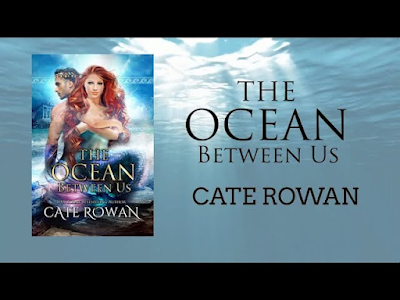
The Ocean Between Us is about a mermaid named Mareisa who is cursed to live on a desert island as a siren to sink any passing ships with her uncontrollable song. To her surprise and delight, one of those ship's passengers survives and makes his way to the island, where he is no longer held by the grasp of her song and has the opportunity to get to know her as a person. That man is a prince named Kyros, who is on a quest to find his lost brother before his ship sank. Now he is trapped on the island with Mareisa and has nothing left to do but get to know her while she treats him like a mortal plaything to entertain her after years of loneliness. Despite this unhealthy start to the relationship, the two inevitably fall in love.
Though the book is quite erotic, there is very little sexual activity between the main couple to Mareisa's great dismay due to Kyros values as an honorable man. The majority of the book involves heavy flirtation between the two, which is made all the more torturous to Kyros because Mareisa, like most sirens, is a nudist. I suppose it's an old romance trope to have a couple stranded on a deserted island together where no one is around to judge them, although it is not one that I have read many stories about. I'm glad the book was relatively short because the "Will they? Won't they?" drama became trite rather quickly. I was far more interested in learning about the two characters' backstories, which appear to be the focus of the later books in this series.
As far as worldbuilding goes, this book is pretty lackluster. Mareisa is a mermaid, but she spends most of her time as a human on land, and very few details are given about the underwater kingdom where she came from. The Greek mythology elements also don't into much detail. Mareisa reveals that she was engaged to Poseidon and was betrayed by her sister, Phi, who took her place as his bride and cursed her to live on the island forever. There are very few references to any other gods or goddesses from mythology. It was written as an adult romance first and foremost, and everything else comes second.
All in all, The Ocean Between Us is a short adult romance book with some hints of fantasy and mythology. It is the first book in a series called Hearts of Olympika, but it didn't motivate me enough to want to read the rest. It has a simple character-driven plot with loads of sexual tension. The most interesting parts are the main characters' backstories. I would have preferred to read a prequel about these instead of hearing about them after the fact, but there is a much stronger focus on romance than fantasy or adventure. I would recommend this book to someone who is looking for a light fantasy novel that is more mature than the average YA fairy tale retelling.
February 17, 2023
Check Out These New Princess Teasers!
After a disappointing Super Bowl Sunday that did not reveal the promised trailer for the live-action remake of The Little Mermaid, Disney quietly dropped the 30-second TV spot online a couple of days ago. This is a teaser rather than a trailer with even less content than I was hoping for. Half the video shows footage that has already been released at the D23 Expo, while the other half reveals two-second flashes of additional scenes from various points in the movie. They are so quick that you might miss them if you blink. The only way to get a good look at what's going on is through screenshots.

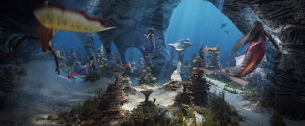
One clip features our new Ariel bouncing off a phosphorescent pink cloud of translucent jellyfish. This is a fun little image that gives us a first look at the movie's visual effects in creating the fantasy underwater kingdom of Atlantica from the original film. Her playful movements are reminiscent of the showstopper "Under the Sea" number, which might be where this clip comes from since the teaser did not contain any new audio. We also see how Ariel's tail and top seem to shift in color between purple and green based on the lighting, making the difference between them more subtle than the original film. This is a clever tribute to mermaid-inspired makeup, nail polish, and other products that have been released over the years that shift between these two colors in different lighting and was likely inspired by Ariel's color combination from the animated classic. Another clip reveals a first look at five of Ariel's six sisters, who have been renamed and redesigned for this version of the film. Instead of the monochrome shells and tails that her animated sisters donned, these new mermaids are to be inspired by real fish with scaly color combinations such as blue and gold or orange and red. It gives them a more authentic look that further separates their identities from the original film.
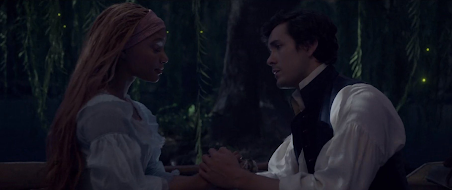
One of the biggest reveals from the teaser is a first look at the "Kiss the Girl" scene, featuring Halle Bailey as Ariel in the iconic boat with Jonah Hauer-King as Prince Eric. Though it's only a brief flash, we see the moment where they nearly kiss just before Ursula's inevitable interference. The frilly white top that Ariel wears and formal attire on Prince Eric remind me more of the Broadway version of this scene than the original animated one. Ariel appears to have a pink headband in place of her big blue hairbow because princesses must always accessorize. Smaller moments in the teaser include Ariel reaching toward her reflection under the surface, making faces at a blowfish and a very brief flash of Ursula's eyes behind one of her tentacles. It wasn't enough to show us what Ursula will look like in the final film, but that might be because the visual effect artists are still working on it. You can watch the teaser below, and keep your fingers crossed that we get a full-length trailer sooner rather than later!
Another surprise teaser that dropped today was for Bad Cinderella, the American version of Andrew Lloyd Webber's Cinderella stage show. I wasn't impressed when this new version of the song first dropped, and I'm even less impressed after seeing it in action. Carrie Hope Fletcher's performance of this song was brilliant, and the costumes were perfect. I loved her black and green goth dress, comfy overcoat, and rebellious fingerless gloves as well as the beautifully embroidered pastel-shaded fairy tale costumes that the inhabitants of Belleville wore. This new version, which recently dropped on Twitter, features Linedy Genao performing a much angrier version of the song with lyrics that don't flow or rhyme as well as the original wearing bright red pants, an oversized leather jacket, and surrounded by villagers who look like a rainbow threw up on them. I think the change in the show's title from "Cinderella" to "Bad Cinderella" articulates how I feel about this new version better than I can. If this is what Andrew Lloyd Webber thinks would be more appealing to an American audience, I have never been more ashamed to be American. You can watch the tweet with the teaser below.
Beating you to it! Here’s a Belleville bootleg to celebrate our first preview.
— Bad Cinderella on Broadway (@badcinderella) February 17, 2023
p.s. we don’t support illegal recording in our theater and will be reporting your posts xoxo pic.twitter.com/a5DIkPNm8L
So what do you think of these new teasers? Are you excited to see more of The Little Mermaid and Bad Cinderella, or would you prefer to stick to the originals? In both cases, I think nothing can beat the originals, but I'm still morbidly curious about the newer ones. The problem with teasers is that they're too short to provide a clear picture of what we can expect and are normally used to build up hype without much context. In the case of The Little Mermaid, the hype was minimized as a result of dropping it randomly instead of during the Super Bowl as originally promised. Rumor has it that we may not get a full trailer until late March or early April, only a month or two before the movie will premiere. As far as Bad Cinderella goes, despite how I feel about the changes, I'm eager for there to be a good princess show on Broadway because the only other one that's currently in production is Britney Spears' Once Upon a One More Time, which looks awful. Did these teasers satiate your thirst for future princess content? Let me know in the comments!
February 12, 2023
Vintage Princess Fantasy Sequences

The first princess fantasy sequence comes from the 1939 film The Little Princess starring Shirley Temple, which is based on the book A Little Princess by Frances Hodgson Burnett. Though the story does not actually feature any princesses, Sara Crewe's philosophy that every girl is a princess made it appropriate to include a dream sequence that presents its heroine as a magical fairy tale princess. Princesses rarely get their own royal throne and entourage that is separate from the king and queen, but this scene is a pure fantasy that celebrates everything that has made princesses so beloved and popular over the years. It features Shirley Temple as Sara Crewe in a beautiful long gown of white silk with golden accents wielding a crown and scepter as numerous servants dote on her hand and foot. The wicked headmistress from the film is presented as a Maleficent-like villain who performs a song with Shirley Temple attempting to persecute two of her employees for being in love. Shirley's character pardons the couple and proceeds to watch a doppelganger of herself perform a lovely ballet sequence.
A lesser-known movie with a similar sequence is Her Highness and the Bellboy, a black-and-white film featuring the brilliant Hedy Lamarr as a foreign princess named Veronica. One of the things that makes this movie unique is that it places a clear divide between the fantasy of being a princess and the reality of it. Though she is very regal, Princess Veronica is not a particularly happy person due to her duties getting in the way of her personal desires. Jimmy, the film's protagonist, is a bellboy with delusions of grandeur who gets so caught up in the fantasy of working for a real-life princess that he neglects his girlfriend, Leslie, who is struggling with health issues. As a result, Leslie has an elaborate dream that is similar to the one in The Little Princess in which she gets to don a gown and tiara and share a romantic dance with Jimmy as her prince. The dichotomy between this scene and Princess Veronica's struggles shows that the fantasy of being a princess is very different from reality. Although everything works out in the end, my personal opinion is that Leslie should have dumped Jimmy for someone who was more grounded in the real world.
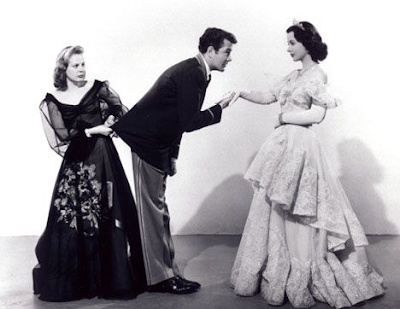
The concept of the princess fantasy was so popular in the '30s and '40s that even Disney's 1937 Snow White and the Seven Dwarfs almost featured its own fantasy sequence despite already being a fairy tale. The iconic "Someday My Princess Will Come" is now known for the simplicity of Snow White simply sitting in a chair and telling the dwarfs a story. At one point, it was going to be an elaborate dreamscape in which Snow White envisions herself riding a romantic swan boat in the clouds and sharing a dance with her prince in a fantasy wedding dress while cartoon stars with faces dance around them. The scene was ultimately cut for being too much of a "heightened fantasy" as well as being too difficult to animate. Though none of the sequences in these films are necessary to tell the story, the live-action ones in The Little Princess and Her Highness and the Bellboy add an enhanced sense of surrealism that would not have been as necessary for an animated fairy tale musical like Snow White. Still, I would love to have seen this sequence fully animated if only for aesthetic reasons.
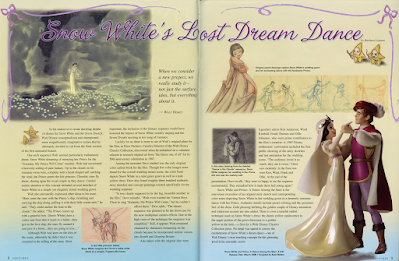
The princess fantasy sequence is not something that we see as often in modern films. One reason for this might be that technology has come such a long way that filmmakers are now able to produce full-length features that take place entirely within these elaborate and heightened fantasy worlds. Another possibility is that the themes in movies like Her Highness and the Bellboy have become more nuanced, so filmmakers want to provide a more literal portrayal of the positive and negative aspects of royalty within the same world instead without extraneous dream sequences. Whatever the reason, these beautiful fantasies have continued to inspire classic scenes in other animated princess movies, particularly those of Don Bluth such as Thumbelina and Anastasia . The most modern and nuanced portrayal of this concept is 2021's WandaVision, which constantly dances on the line between fantasy and reality due to the Scarlet Witch's unique reality-altering powers. Do you miss these vintage dream sequences that portray an idealized version of reality, or do you prefer the more nuanced modern portrayals that showcase the good and the bad in the same settings? Let me know in the comments!
February 5, 2023
Review: Of Chivalry and Revenge

Most of my Arthurian knowledge comes from vague high school memories, the BBC's Merlin series, and obscure references in Princess Gwenevere and the Jewel Riders. This book relies heavily on the original source material but flips things around just enough to sympathize with Morgana. When I say "just enough," I mean it. Morgana is by no means a purely sympathetic character here. She tries to kill King Arthur multiple times and genuinely believes that she is evil until near the end. It is told from the perspectives of both Morgana and Lancelot, who is her love interest in this version of the story. Lancelot is very much the character we are familiar with from legend--a brave and noble night who briefly has eyes for Queen Guinevere. However, in this version, Morgana is the one who truly holds his heart. It reads like a simplified version of Celeste Baxendell's last book, Sands of Deceit , which was also about a character who needed the love of a good man to give up her wicked ways.
The book is short enough to be completed within a day or two, though I would argue that most of the story is already resolved after the first half, which is told from Morgan's perspective. The second half reiterates a lot of what we've already been told, this time from Lancelot's perspective. I'm not sure I enjoyed the backtracking element that much. The book may have been more cohesive if it alternated perspectives within the same timeline like many other books in this style tend to do. There wasn't enough new content for Lancelot to justify retelling the entire story a second time. Even Morgana's section seemed lacking, and her transition to goodness wasn't that easy to swallow after the book starts with her intending to kill Arthur and only saving him by accident. It's definitely a modern story that showcases recent media trends of forgiving villains instead of defeating them.
Where this book really falls short is its lack of detail about Merlin, a beloved character with a variety of iterations in many forms of media. In this version, Merlin is portrayed as a master manipulator who exhibits his control over Morgana by erasing her memories. Merlin is already dead by the time this story begins, and there are no flashback sequences that reveal his true nature and intent. It seems like it was building him up as a villain, which would have been very interesting because that is not something that I've seen done before. Yet, it never quite explains his motivations in controlling Morgana and whether or not he gave the same despicable treatment to anyone else, particularly another apprentice we meet at the end of the book. It was just enough of a tease to make me want to know more and never quite satisfied that craving.
Overall, Of Chivalry and Revenge is a good book if you are in the mood for something light and don't have a lot of time to delve into a complex fantasy world. Most people should already be familiar with the characters going in, so no previous knowledge of the Bewitching Fairy Tales series or any other new lore is necessary. If you are looking for a more complex psychological drama, you probably won't find that here. I think if this book had a prequel that went into detail about how Merlin was using Morgana and why she turned evil, it would be a more compelling read than this was.
February 4, 2023
Story Saturday: The Dancing Prince
I was inspired to write this story after reading the version of "The Twelve Dancing Princesses" in The Red Fairy Book. It was one of my favorite stories as a child. In this version, the princes that the princesses dance with in their underground world were other candidates who tried to learn their secret and were brainwashed by a magic potion to forget everything but the love of dancing. As soon as I saw that, I knew there was another story in there. This is that story.
"The Dancing Prince"Prince Justin loved Princess Calliope with all his heart, but no matter how he tried to convince his parents to break off his alliance to Princess Jessamine, they simply would not listen to reason. Even after Calliope's father issued a contest to learn the secret that she shared with her eleven sisters with the prize of marrying one of the princesses, Justin's parents still would not relent."You may enter the contest if you wish," they told him, "but you may not accept one of those princesses as your wife. You will marry Princess Jessamine."
In truth, Justin already knew the secret of where Calliope and her sisters disappeared to every night that caused their dancing shoes to become worn and tattered each day. His beloved Calliope had confided her secret to him about how they discovered a hidden underground world beneath the castle with endless wonders, feasts, and music. It was the only thing that gave the girls happiness in their otherwise restrictive lives. As such, he would never betray their secret without permission.
As Justin's inevitable marriage to the vain Jessamine drew closer, Calliope decided to help him escape.
"Run away with me to our secret world. No one will ever find you there," she said.
Justin didn't love the idea of running away from everything he knew, but it seemed like the only way to get out of his marriage and be with his beloved. So, on the night before his wedding, he slipped off to Calliope's kingdom, where he proclaimed to the king that he wished to take the challenge, unbeknownst to his parents. By the time they found out where he had gone, it was too late.
Celia, the eldest of Calliope's sisters, suggested that they give Justin the magic tonic so he would forget his troubles and live happily amongst the other princes who had failed to guess where they went at night. However, Calliope would hear nothing of the sort.
"He may forget his troubles, but what if he forgets his love for me?" she cried.
So it was agreed that Prince Justin would join the others in their hidden world, but he would be the only one to keep his wits about him. The other princesses knew him well enough to trust he wouldn't try to escape and betray their secret.
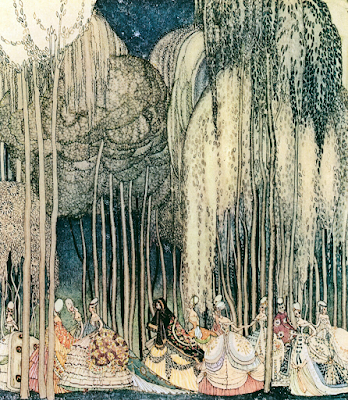
Prince Justin followed his beloved down a hidden staircase in the princesses' room that led to an enchanted river, escorted her onto a glittering boat, and traveled through forests of silver, gold, and diamonds, where they came to a massive banquet that was even grander than the wedding that had been planned for him and Jessamine. Justin danced the night away with Calliope, forgetting his troubles until she and her sisters had to return to their rooms so they would not be caught by the castle staff.
Over the next few months. Justin began to feel some guilt, not only for running away, but also for the other princes who were trapped in the enchanted fairyland. At first, they seemed like friendly sorts who kept him occupied as he awaited his beloved Calliope each night, but the more he spoke to them, the more he began to understand how the tonic affected their minds. They could speak of nothing other than dancing and how beautiful and graceful the princesses were who came to visit them each night. While Justin could not disagree, he found that their faces went blank when he mentioned anything else that he enjoyed in the world above, like horseback riding, foreign affairs, or fencing. None of the princes seemed to have any memories of their lives before they entered the enchanted woods, and that made him sad.
"What you've done to them isn't right," he said one night when the princesses arrived for their nightly ball. "They've been taken from their homes and forgot everything they once loved except for dancing."
"They're happy enough," argued Celia, the eldest. "Look how much fun they're having dancing with all my sisters."
"They chose to be here, just like you did," argued Calliope.
"No, my love," said Justin. "They thought they could solve the mystery and marry one of your sisters, not become trapped in an endless cycle of dancing."
"I suppose you're right," she said, "but if you were to tell my parents now, this would all be taken away from us, and you'd have to go back and marry Jessamine."
"You're right, I suppose. Perhaps we should wait and see if a solution appears," said Justin.
Indeed, a short time later, Justin began to hear the princesses tease the youngest, Lina, about her affections for the new gardener. After that, strange things happened. Lina's boat got inexplicably heavier, and Justin noticed the branches on the enchanted trees snap one by one as they passed them. During their daily banquet, he saw a golden chalice float in midair. The princesses were too busy dancing to notice these things, so Justin decided to take matters into his own hands. He grabbed the chalice and the invisible attached to it.
"Are you a ghost?" Justin asked. "Are you hear to harm the princesses?"
"Nothing of the sort," replied the invisible stranger. "It looks like you've found me out," he said. With that, he removed his invisibility cloak, and Lina gave a shriek.
"Michael?" she asked. "What are you doing here?"
It turned out that the invisible stranger was the very gardener that Lina's sisters had been teasing her about.
"I am here to solve the princesses' mystery, but it looks like this prince has outsmarted me. It's strange how he isn't as obsessed with dancing as the others."
"It isn't so strange," said Justin, "for you see, I am the only one here who did not drink the magic tonic that erases the princes' minds."
"Well," said Celia, "It looks like now you can both get what you want. Since our secret has been discovered by an outsider, Father will know the truth by morning, and all of our fun will go away. Let's celebrate your victory with a toast."
She handed both Michael and Justin glittering goblets. They exchanged a look and pretended to hold them to their lips.
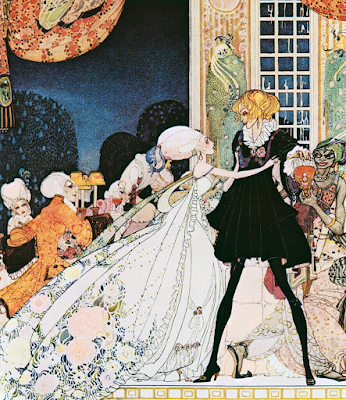
"No!" shouted both Lina and Calliope at the same time, knocking the cups out of their beloveds' hands. "Don't drink it!"
"I'd rather be a gardener's wife," said Lina while Calliope said to Justin "Your happiness is the most important thing to me, even if it means I have to live without you."
But as fortune would have it, the vain Princess Jessamine had decided she was too good for a prince would abandon her on her wedding night and ran off with a lord who had attended the ceremony. That left Justin free to marry Calliope. Michael revealed the secret of the princesses to their father, freeing all of the princes who had been trapped in the enchanted forest. Many of them stormed off in anger back to their kingdoms, but a few had fallen in love with the princesses and forgave them. Now that they had dancing partners for the rest of their lives, they were pleased despite losing their enchanted world beneath the castle, and they all lived happily ever after.
February 3, 2023
Is Disney Retconning Their Little Mermaid (Again)?
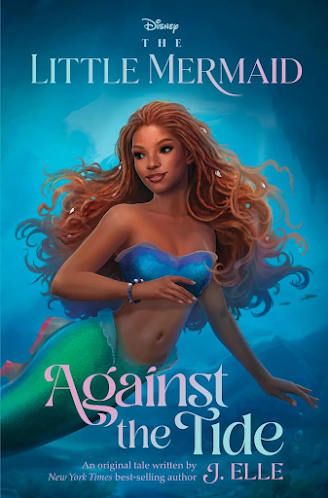
Granted, these changes would work beautifully for an original take on the fairy tale. I am one of many people who has complained that the Disney remakes rarely add anything new or exciting to the original films. The problem here is that Disney is trying to have it both ways. Instead of making a completely new version of "The Little Mermaid," they are picking and choosing elements from their own beloved version, such as calling the character Ariel, giving her flowing red locks, and incorporating Alan Menken's sensational soundtrack among other things. My favorite version of "Cinderella" is Rodgers and Hammerstein's Cinderella from 1997 starring Brandy, which is also owned by Disney, but it is a remake of a different version of the fairy tale, which gives them free reign to change as much of the story as they want without needlessly comparing it to the 1950 animated film like they had to do with the 2015 remake. There's also the fact that the Disney Parks are currently casting actresses to play the live-action version of Ariel, something that has never been done for any other remake before, right on the heels of the re-opening of Ariel's Grotto, where fans can meet the animated version.
This isn't the first time Disney has tried to retcon Ariel's backstory. In 2006, Ariel's Beginning awkwardly revealed that King Triton had banned music from Atlantica for most of Ariel's life even though the animated series, which took place a year before the film (the same time period as upcoming Against the Tide novel) had loads of fantastic songs from creatures all over the sea and made no mention of how they were forced to hide their musical abilities until just recently or needed to learn music again. Granted, that is a minor enough detail to gloss over than the assumption that Ariel was sneaking off on all these adventures with Flounder and Sebastian when she was supposed to be spending her time in the underwater territory of Carinae using her supernatural abilities to protect all the creatures of the sea. I get that the new movie isn't supposed to be related to the series, but is it really such a good idea to give Ariel three completely different backstories when she is only supposed to be one version of a character created by Hans Christian Andersen?
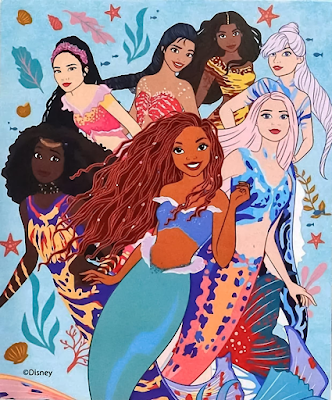
Then there's the complete overhaul of Ariel's sisters who have not only all been renamed, but also completely redesigned and are rumored to have superpowers. Instead of Aquata, Andrina, Arista, Adella, Attina, and Alana, we have Indira, Caspia, Karina, Mala, Perla, and Tameka. Ariel's sisters in the animated movies and series were only given minor personality traits when it was convenient to the plot, many of which got retconned in Ariel's Beginning. Yet, those of us who have been fans for all these years have grown to love the sisters and what little slivers of personality was provided for them. Arista had the most focus in the series as the overlooked middle child who was always jealous of the attention Ariel got from her family and friends. That would have been a great thing to build on for the new movie as opposed to removing her character entirely. If Disney said they were making a completely new version of "The Little Mermaid" like they did with Rodgers and Hammerstein's Cinderella and didn't call their lead character Ariel, I would say this looks like a really neat new take on the story with original mermaids to get to know and love, but they're trying to do both.
As it stands now, my biggest concern is that the version I grew up with is going to be erased. The Disney Princess line has always largely featured the animated versions of the characters, so I take some comfort in knowing that the animated version of Ariel will live on in that respect. Those of you who have been reading my posts up until now know that I have no issue with Halle Bailey playing the character. I'm just hoping that Disney doesn't try to by create an entirely new feminist take on the fairy tale and acting as though this was always "their" version and pretend that the 1989 movie never existed. Up to this point, none of the live-action movies have changed enough of the story to retcon their animated films aside from adding minor details to the characters' backstories. With Against the Tide being canon, not only are Ariel's carefree adventures from the series no longer relevant because of her Protector duties, but everything that we know about her sisters has been erased entirely. Am I overreacting? Maybe. What do you think? Is Disney trying to replace their classic with this new version, or is there a place for both of them to live in harmony?
February 1, 2023
Review: Princess Power (Netflix)
Princess Power is a new animated Netflix series for preschoolers based on the celebrity-endorsed picture book Princesses Wear Pants. I would like to state up front that I am definitely not the target audience for this series, but there has not been a new American animated princess series in at least three years, so we're doing this one. To be fair, one of my favorite shows of all time, Sofia the First has the same target age group, but I would argue that series was written with a wider breadth of audience in mind because it spent so much more time than it needed to on worldbuilding, music, and character development. Princess Power is a lot more obvious about its demographic, and that's fine, but as a result, it has little to offer for adults, parents, or older kids.
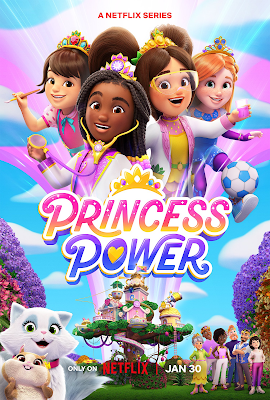
Princess Power focuses on four girls from the "fruitdoms," whose names all start with the same letter as their kingdom's fruit. Penny comes from the Pineapple Kingdom, Rita from the Raspberry Kingdom, Bea from the Blueberry Kingdom, and Kira from the Kiwi Kingdom. They get together to solve minor problems within their corresponding fruitdoms, but since this is a show for small children, there are no villains or major threats. The girls also don't have distinctive personalities. After watching a few episodes, it's possible to determine that Penny is a scientist, Rita likes arts and crafts, Bea is athletic, and Kira is the responsible one, but none of these traits are immediately apparent by listening to the girls in a casual conversation, unlike a show like My Little Pony: Friendship is Magic, where you can immediately figure out which character is talking after hearing a single line. The fruitdom princesses are all bubbly, smart, and energetic, and act consistently throughout the show.
The series is formatted similarly to shows like Doc McStuffins with two 11-minute segments in each episode with a music video near the middle that contains the same song and animation in each segment. It got so repetitive that I started skipping over the song after watching the first couple ofepisodes. I guess it's normal for preschool shows to have repetitive elements because kids like to repeat things, but I got spoiled by Sofia the First, which never repeated any animation sequence and had an original song in every episode. Each segment of Princess Power introduces a small problem in one of the fruitdoms like a princess wanting to throw a party or a lost or broken item that needs to be repaired. They summon their friends with a fruit-version of the Bat Signal get together to solve the problem after a brief music video. There was nothing particularly wrong with any of the storylines, but being a grown-up, none of them held my interest really made me think.
My favorite thing about this show by far is the animation. Even though it's based on a series about princesses wearing pants, the specific pants outfits that they wear are bright, colorful, and over-the-top with bows and sparkles, just the way I like it. I love how all their tiaras and outfits are themed to match their fruit and accented with ruffles and other embellishments that remind me of the clothes I wore as a child. The only thing that confused me throughout the show was why the Kiwi princesses always wore purple instead of green. Are purple kiwis a thing? The girls have fancier dresses that they wear on special occasions that are also very cute. The fruit aesthetic reminds me of Strawberry Shortcake, which may have been one of the inspirations for this series. The colorful confection-themed castles are reminiscent of "Hansel and Gretel."
Princess Power is a cute show for preschoolers but doesn't have much to offer anyone else. Though the 14 episodes on Netflix can be completed in a little over two hours, I can't recommend any episode in particular as being more worthwhile. They all feel like watching the same story over and over again, especially with the redundant songs and animation sequences. I think it's a harmless series for children that encourages friendship and teamwork and has some fantastic costume designs, but I have little interest in watching future episodes unless I have a child. Some ways I would improve it would be to give the princesses more distinctive personalities and harder problems to solve. Would you watch this show on your own or only as a parent? Let me know in the comments!
January 29, 2023
Review: Song of Ebony (Singer Tales)
From the cover alone, it's clear that Song of Ebony is a creative take on your average "Snow White" retelling. Instead of the traditional skin as white as snow and hair as black as ebony, this story presents a protagonist with skin as black and ebony and hair as white as snow. This rare combination insinuates innate supernatural abilities like Storm from the X-Men. The unique properties of this book go beyond mere aesthetics. Deborah Grace White's earlier books were somewhat generic fantasy stories, which is why I never read past the first book in her Kingdoms series of fairy tale anthologies. Since then, she has really managed to hone her craft, especially with her top-notch mermaid series, The Vazula Chronicles that I've been shamelessly recommending to anyone who likes mermaids. When I found out that Deborah was starting a new fairy tale anthology called The Singer Tales, I couldn't wait to find out what was in store.

Song of Ebony is the premiere book in The Singer Tales, a new anthology of fairy tale retellings that focus on princesses with magical singing abilities. I love how this concept is a subtle reference to Gail Carson Levine's Fairest, one of my favorite "Snow White" adaptations from before the fairy tale retelling craze took the independent publishing world by storm. With the theme of magical singing abilities, it's no surprise that the next book in this series is Song of the Sea , which will be based on "The Little Mermaid," my favorite fairy tale. This upcoming book was heavily foreshadowed in Song of Eboy, which is a wonderful fantasy take on "Snow White." Bianca is a magical princess with snow-white hair that serves as a visual representation of the singing abilities that she denies having for most of the book. Instead of seven dwarfs, she encounters seven elves who place her under their protection when they learn that her stepmother is trying to kill her. And that's just the beginning of this magical story.
What I love most about Deborah Grace White's other recent works is how much care she puts into building a rich and believable fantasy world. This story takes place in a land of animosity between humans and elves caused by jealousy of their varying magical abilities. In this world, the natural ground is fatal to most humans because it is filled with wild magic, and humans, who are mostly non-magical, don't have the capacity to handle that level of power. As a result, human lodgings are built above ground in the treetops. When Princess Bianca is seen plummeting to the ground after her stepmother's orders to kill her, she is presumed to be as good as dead, yet she miraculously survives. This causes her to cross paths with another human who survived on the ground of her kingdom, a young prince named Farrin, who provides shelter for her among his elf companions. I appreciate that the story only focused on two of the seven elves because it would have been difficult to try to keep track of all of them. Lurgl is the leader who was slighted by the rest of the elven kind, and Dionysius is this book's equivalent of Grumpy who doesn't trust Bianca and hates having her around.
This adaptation does a fantastic job of staying true to the original story in spite of all of the creative changes. Marisol, Bianca's stepmother, was vain and power-hungry and took some despicable measures to become queen and get rid of the king. Like in the fairy tale, there are three attempts on Bianca's life--one with a ribbon that wraps around her body like an over-tightened corset, one with a poisoned comb, and one with a poisoned apple. It even includes the part about only poisoning half the apple so that the stepmother can take a bite out of the green half to prove that it's safe and convince Bianca to eat the poisoned red half. The book also has the same moral of being careful about who you trust. Bianca is painfully aware that her trusting nature might get her killed someday, yet no matter how much she tries to change it, Marisol continues to find new ways to bypass Bianca's newfound cynicism. I also liked how the romance between Bianca and Farrin was built up from the beginning of the book without changing too much of the original story.
If you are a fan of "Snow White" and want something a little different, Song of Ebony is a must-read. It flips the script on the original fairy tale just enough to be unique without ruining what made it such a good story in the first place. I love how the white hair provides an opportunity to change Snow White's skin color without drastically altering the story, something that Disney did not seem to do with their upcoming remake. The world-building in this book is fantastic and makes me eager to read the rest of the series, especially the upcoming "Little Mermaid" adaptation. Deborah Grace White put a great deal of thought into the magic system and the setting in which these books take place. This is one fairy tale series you don't want to miss out on.
January 22, 2023
How Andrew Lang's Fairy Books Started the Princess Craze
Though it feels like fairy tales have been around forever, the popular versions that we know today have actually only been circulating in English-speaking countries for a little over a hundred years. Much of this is thanks to a name that we rarely hear associated with fairy tales, Andrew Lang. Lang didn't write any fairy tales himself, but he was one of the first people to translate stories from the Brothers Grimm, Hans Christian Andersen, Charles Perrault, Madame d"Aulnoy, and others into English to introduce them to a wider audience of fantasy lovers with the Fairy Books of Many Colors, a 12-volume encyclopedia of fairy tales from all over the world. Lang was a scholar who published a number of periodicals, poems, and fiction, but he was most famous for annotating these stories that were translated by his wife and illustrated with beautiful ink drawings by H.J. Ford. Thanks to the magic of the internet, I was able to acquire a full set of the Fairy Books at a relatively decent price through Dover Publications on Amazon.

What separates these books from single-author anthologies like the Brothers Grimm or Hans Christian Andersen is that the stories in each color book are strategically selected from around the world to create the most entertaining collection possible to fill approximately 350 pages of content each. I've read full anthologies of the Brothers Grimm and Hans Christian Andersen (as pictured on my shelf), and both of these contain quality fantasy stories about magic and princesses mixed in with a large number of duds about talking animals or weird anecdotes that end abruptly and don't quite fit with the rest. Though Andrew Lang's books contain many stories I was already familiar with, they have an equal mix of obscure fairy tales from other cultures that have the same level of fantasy and adventure as the popular ones. Another thing I love about his books is that almost every story contains a beautiful princess. What's great about the Dover editions in particular is that they contain each and every one of H.J. Ford's beautiful illustrations that really pull the reader into the world of these stories when the writing can get too dry. Each book contains roughly one hundred drawings that set the tone for each story.

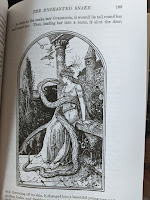
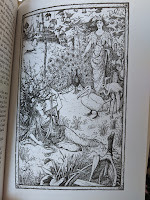
Most of the commonly known fairy tales are in the first few books--The Blue Fairy Book, The Red Fairy Book, and The Green Fairy Book, so continuing down the line reveals more and more lesser-known stories with similar themes. Even the stories I was already familiar with had something new to offer from these early adaptations. For instance, the Fairy Books' version of "Jack and the Beanstalk" reveals that the treasures Jack found in the giant's castle at the top of the beanstalk rightfully belonged to his family and were stolen from his parents before he was born. In this version of "The Twelve Dancing Princesses," it is revealed that the princesses' dance partners in their secret underground world were other princes who tried to figure out what they were doing each night and fell under their spell. Cursing their dance partners instead of the princesses themselves might be better fodder for a full-length adaptation of this story than some of the ones I've read. There's also a version of "Goldilocks and the Three Bears" that features an old woman instead of Goldilocks and an unrelated story about a princess named Goldilocks.
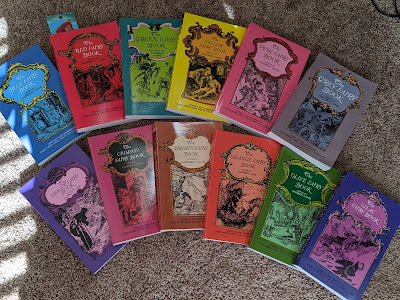
I've only completed the blue, red, and green books so far and am working on the yellow one. I've already learned a lot about the evolution of fairy tales. These books taught me just how many different versions have spread among various cultures of the same or similar stories. As expected, the books contain several different versions of "Cinderella," the most retold story of all time, but there are other stories and themes that are also repeated often. For instance, a popular story with many adaptations involves three brothers who leave home to become adults and support their families. In these stories, the youngest and most ostracized brother is always the one who finds the most success and ends up winning a beautiful princess. They also need to perform three tasks every time. The rule of threes is also popular in fairy tales. Characters going on quests must almost always perform three tasks or repeat the same three actions every time before something different happens. This rule was the reason Disney decided to give Aladdin three wishes even though the genies from the original fairy tale granted unlimited wishes. Princesses are typically treated as prizes to be won in older fairy tales, and the amount of agency they have changes depending on the story. There's also a recurring theme of animal transformations. In many stories, the protagonist will encounter a talking animal who gives them advice for their quest. If they are diligent in following the advice, the animal usually transforms into a beautiful prince or princess who marries the main character at the end.
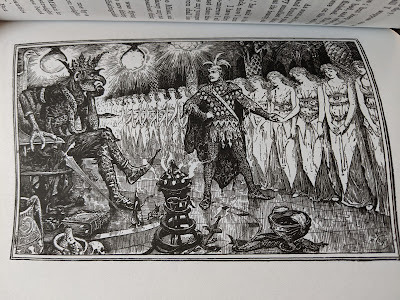
Reading the original translations also reveals some of the less pleasant parts of history that modern media often tries to cover up or avoid. For instance, some of the stories reference slavery, and there is always a strong focus on beauty correlating to virtue, something that was overplayed in The School for Good and Evil , a modern take on older fairy tales. Beautiful characters are always kind, whereas cruel ones are always ugly. A particularly outdated story that would never be accepted in today's world is "One Eye, Two Eyes, and Three Eyes," in which the only sister who passes as "normal" because she has two eyes is ostracized by the rest of her family, who thinks they are special for having one and three eyes, respectively, and torment her in a cruel fashion until she manages to find a way out. In today's society (and the real world in general), it would be the ones who are different who would get ostracized and need to find their own happiness instead of punishing people who already fit in. One of the only stories I read so far in these books with a prince and princess who are considered conventionally ugly but still virtuous is "The Golden Branch," but even that one ends with the fairies giving them the gift of beauty as a reward for their struggles.


The one story that I was the most disappointed not to find in any of the twelve Fairy Books is "The Little Mermaid," my favorite fairy tale from Hans Christian Andersen. Fortunately, I was gifted a few years ago with a rare first-edition anthology of Hans Christian Andersen's fairy tales which does contain that story, so I keep it on my shelf next to the Fairy Books of Many Colors. Speaking of "The Little Mermaid," there was a recent leak of the upcoming trailer for the latest Disney adaptation of the film. The full trailer is rumored to go public tomorrow or within the coming week, so I will be here to provide coverage when it does. It's interesting to see just how much these stories have evolved since the original translations were leaked in the late 19th century. Do you know any obscure fairy tales that have become obsolete or lost to time? Let me know in the comments!



